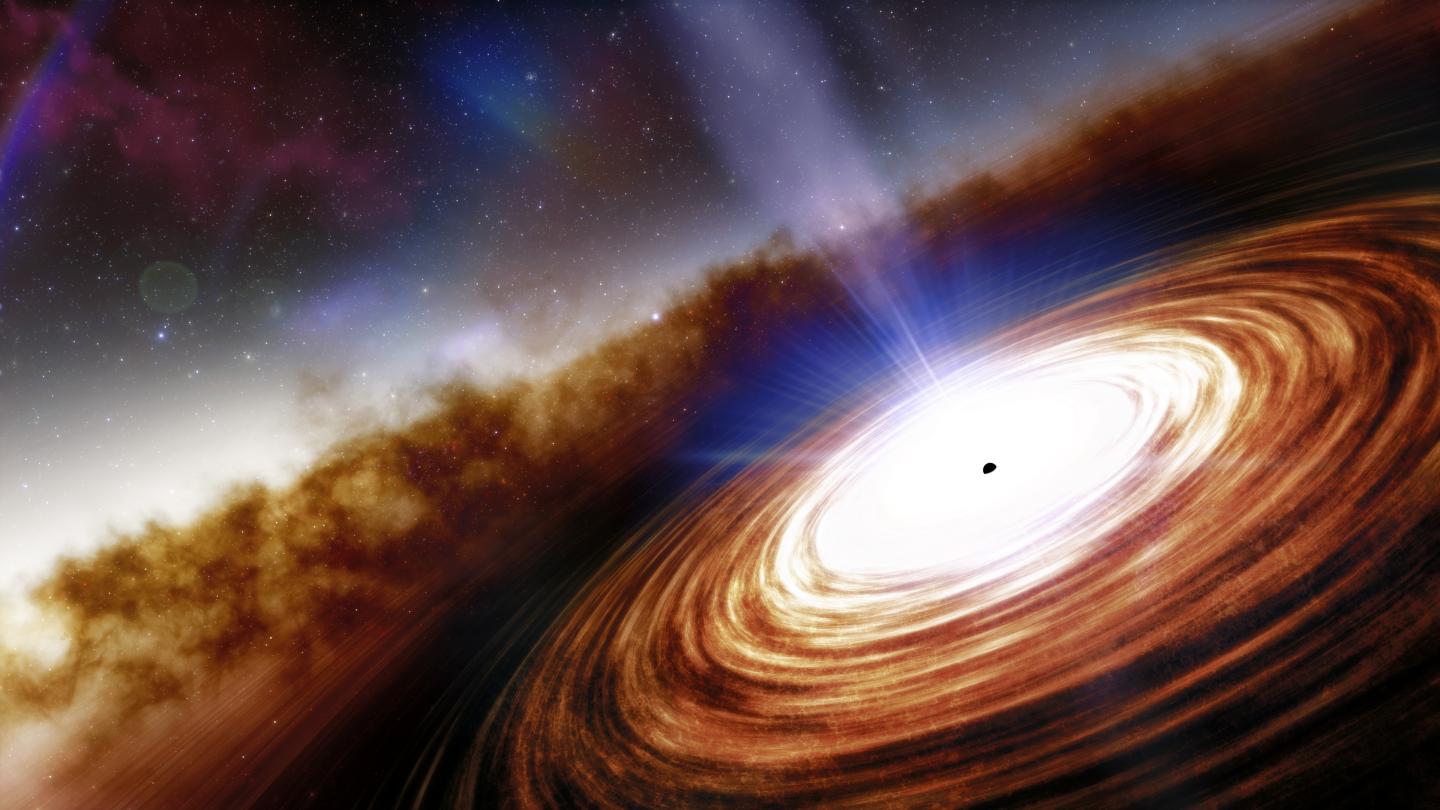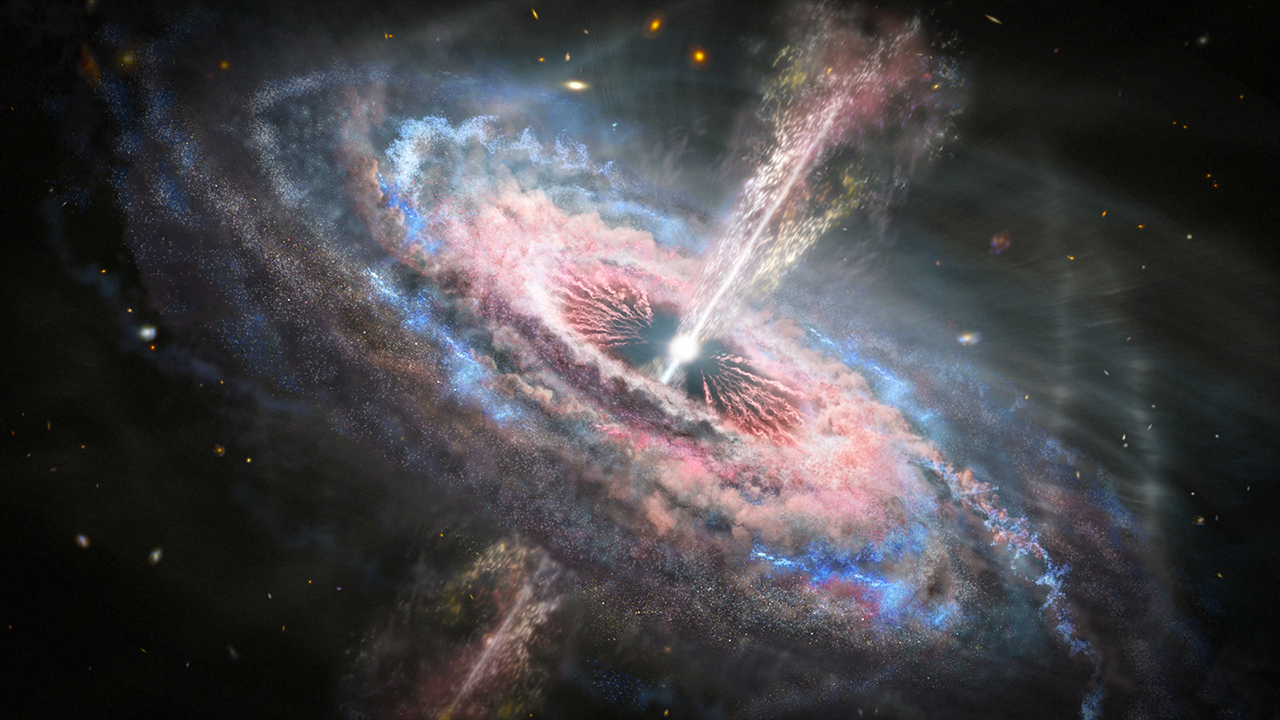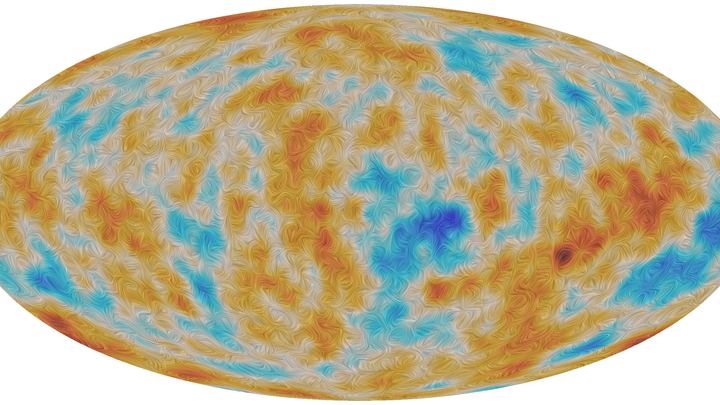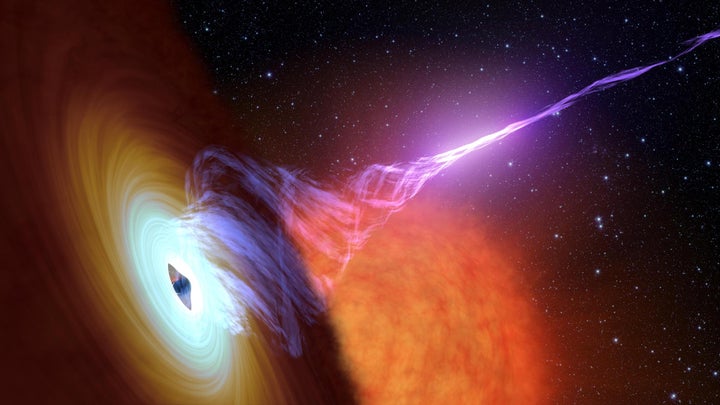
What we can learn from baby black holes
The quasar J0313-1806 is 13 billion light-years away from Earth. But it still can reveal a lot about our own universe.
- Space
- Science
 An artist's impression of J0313-1806, a quasar with a young supermassive black hole at its core. NASA Hubble fellow Feige Wang helped identify and model the astronomic body. NOIRLab/NSF/AURA/J. da Silva SHARE
An artist's impression of J0313-1806, a quasar with a young supermassive black hole at its core. NASA Hubble fellow Feige Wang helped identify and model the astronomic body. NOIRLab/NSF/AURA/J. da Silva SHARE This story originally appeared in the Youth issue of Popular Science. Current subscribers can access the whole digital edition here, or click here to subscribe.
var siteRootDomainParts = window.location.host.split("."); var siteRootDomain = window.location.host; if ( siteRootDomainParts.length >= 2 ) { siteRootDomain = siteRootDomainParts[siteRootDomainParts.length - 2] + "." + siteRootDomainParts[siteRootDomainParts.length - 1]; } cnxps.cmd.push(function () { cnxps({ playerId: "d0aa10a3-c0c5-48e8-865e-f5d73ae74404", customParam1: window.empire.apps.ads.targeting.pageId + "", customParam2: window.empire.apps.ads.targeting.section + "", customParam3: window.empire.apps.ads.targeting.keywords + "", settings: { advertising: { macros: { cust_params: "site=" + siteRootDomain + "&targeting_article=" + window.empire.apps.ads.targeting.externalId + "&targeting_section=" + window.empire.apps.ads.targeting.section + "&targeting_keyword=" + window.empire.apps.ads.targeting.keywords + "&article=" + window.empire.apps.ads.targeting.pageId, article: window.empire.apps.ads.targeting.pageId, category: window.empire.apps.ads.targeting.section, keywords: window.empire.apps.ads.targeting.keywords, } } } }).render("404a5343b1434e25bf26b4e6356298bc"); });When Feige Wang was growing up in Shandong province, China, he liked gazing up at the night sky to look at the stars. Now, as a NASA Hubble fellow at the University of Arizona’s Steward Observatory, he looks much deeper into the darkness to contemplate the most distant objects ever studied.
His targets, quasars, are black holes surrounded by disks of gas and stars—the nuclei of primitive galaxies. Their dark hearts suck in nearby matter and crush the absorbed material into a superhot disk, which burns bright as it shoots out immense amounts of energy. That’s the feature that allows us to spot them from so far away. But because it takes billions of years for their light to reach Earth, we see these beacons in the blackness as they existed eons ago.
[Related: How old is the universe? Our answer keeps getting better.]
As one of today’s foremost quasar watchers, Wang uses them to gaze into the universe’s ancient history. “In the past couple years, I have been pushing to find the most distant ones,” he says, since every additional light-year of distance equals another year of cosmic time travel.
In 2021, using a trio of telescopes in Chile and Hawai’i, Wang and his colleagues discovered the farthest quasar yet. Dubbed J0313-1806, it’s more than 13 billion light-years away, which means Wang saw it as it was just 670 million years after the Big Bang—when it was practically a newborn.
Wang finds the quasar’s black hole particularly fascinating, because according to our current understanding of astrophysics, it shouldn’t exist.
J0313-1806 confounds scientists’ current theories. Black holes of its size are thought to grow from relatively small “seeds” that then suck up mass over time. One model states that the very first stars might have left such seeds in their wake after living fast and burning out young. Otherwise, clusters of stars collapsing in on themselves could come together to make good fodder.
But neither scenario can explain J0313-1806. Its center is around 1.6 billion times the mass of the sun, and about 500 times more massive than the black hole at the core of our own galaxy. At that point in the universe’s history, the cosmos simply hadn’t churned out enough stars to explain the sheer size of J0313-1806’s immense center.
Instead, Wang and his colleagues think that raw hydrogen may have seeded the massive object. It’s possible that a cloud of gas collapsed, eventually becoming dense enough to birth a black hole, which then ate up stars and other gas. But without other quasars of comparable age to observe, the black hole’s provenance remains a mystery.
“We have very little information about the large-scale environment of the earliest quasars,” Wang says, since observers are limited by the reach of current instruments.
[Related: Flickering light could help astronomers weigh supermassive black holes]
But he is optimistic that the next generation of sky-watching machines will help us uncover these secrets. The long-awaited James Webb Space Telescope, set to launch in late 2021 and take the throne of the 30-year-old Hubble, will allow astronomers to peer farther back into time than ever before—and take a closer look at J0313-1806. Other incoming scopes will help as well. Chile’s Vera C. Rubin Observatory, expected to open in 2023, will scour Earth’s southern skies for new quasars, among other things. The Nancy Grace Roman Space Telescope should enter orbit in 2025, where it will peer at infrared wavelengths to spot far-out matter.
Wang hopes such tools will reveal much more about how the earliest black holes grew. “The next decade will be a great time for studying the most distant objects in our universe.”
 Rahul Rao
Rahul Rao Rahul is a freelance science journalist, graduate of NYU's SHERP, and Doctor Who fan. Contact the author here.
Ask Us Anything big bang black holes fall 2021 physics MORE TO READIntroducing Jobbguru: Your Gateway to Career Success
The ultimate job platform is designed to connect job seekers with their dream career opportunities. Whether you're a recent graduate, a seasoned professional, or someone seeking a career change, Jobbguru provides you with the tools and resources to navigate the job market with ease.
Take the next step in your career with Jobbguru:
Don't let the perfect job opportunity pass you by. Join Jobbguru today and unlock a world of career possibilities. Start your journey towards professional success and discover your dream job with Jobbguru.
Originally posted on: https://www.popsci.com/science/quasar-black-hole-tells-age-universe/


